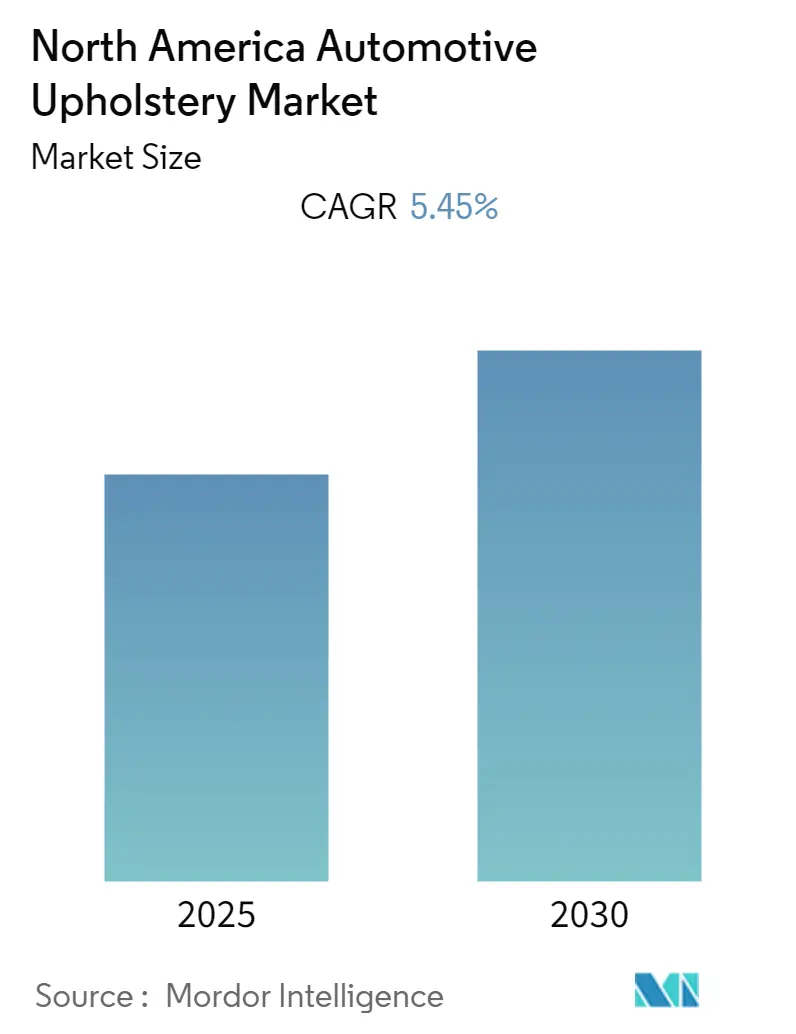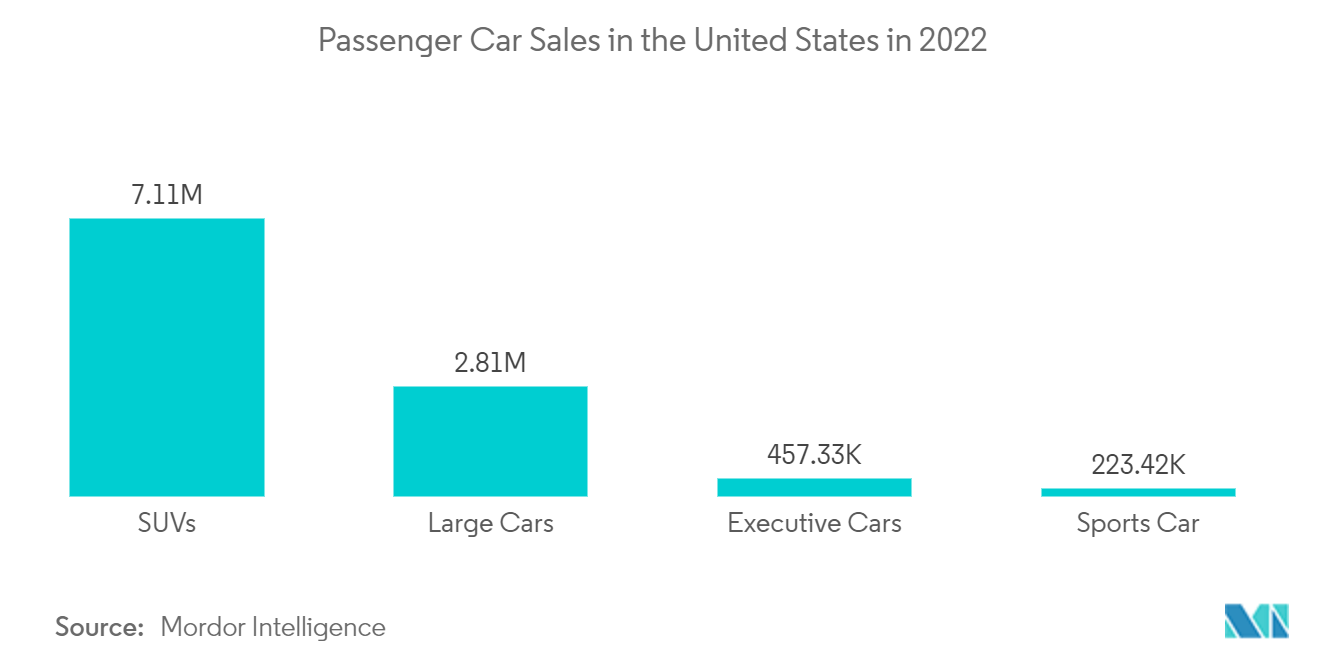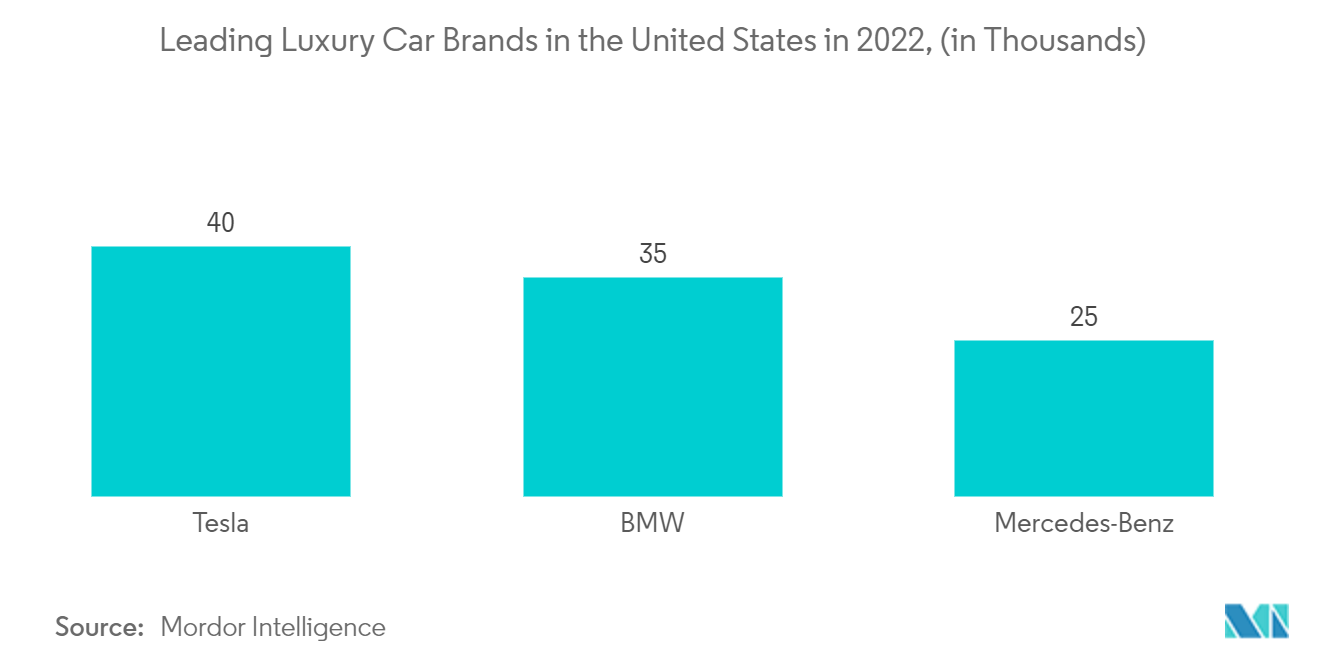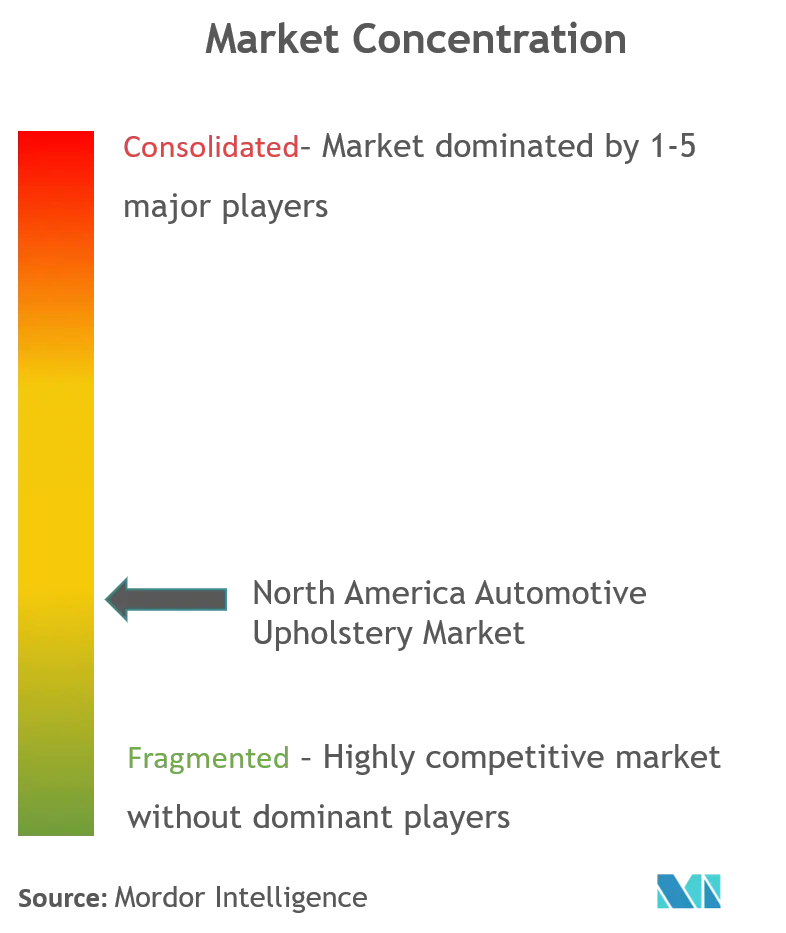
North America Automotive Upholstery Market Analysis by Mordor Intelligence
The North America Automotive Upholstery Market is expected to register a CAGR of 5.45% during the forecast period.
Over the long term, demand for innovative automotive technology and vehicle interiors is likely to drive demand in automotive upholstery throughout the forecast period, with a growing emphasis on lightweight automotive materials and the development of various non-fabric replacements.
Furthermore, the increased demand for customized interiors in vehicles has contributed. The demand for more personalized vehicles is growing around the world. Car customization plays a significant role in making the car more personalized, owing to which the need for top-class upholstery is growing. Another factor that is driving the Automotive Upholstery demand is the rise in autonomous driving and luxury car sales. Furthermore, numerous automotive manufacturers are concentrating on manufacturing better products in order to provide better products to their clients.
For those interested in adding a luxury element to their cars, leather has remained in demand amongst the wealthy. Moreover, it is known for giving a premium look and feel. As a result, leather upholstery offers certain utilitarian benefits over ordinary materials used in car interiors. This is forcing automakers and OEMs to provide leather upholstery in their mid-range and premium car offerings, thereby driving the development of the leather segment of the automotive industry.
On the other hand, shifting raw material prices and rigorous government laws and regulations for lowering HAP (hazardous air pollutants) emissions are expected to limit market growth. Nonetheless, the emergence of self-driving cars creates new potential for North American automotive upholstery producers during the projection period.
However, the rising cost of raw materials and early wear and tear leads to cut-throat competition amongst the upholstery manufacturers. Nevertheless, engineers are developing innovative and affordable materials that can both satisfy the aesthetic and the damages to the upholstery as a result of smoking, liquid spillage, and collisions.
North America Automotive Upholstery Market Trends and Insights
Increasing Demand for Aftermarket Upholstery Modifications May Drive the Market
Aftermarket upholstery modification allows to personalize and customize the interior of vehicles according to preferences. Aftermarket upholstery offers a wide range of materials, colors, and patterns not typically available in OEM options. It also allows for repairs or upgrades to worn-out or damaged seats, enhancing comfort and aesthetics.
Furthermore, customers may choose aftermarket upholstery to improve durability, add special features like heating or cooling elements, or incorporate unique designs that reflect their personality. Overall, aftermarket upholstery modifications provide a way to enhance the interior of vehicles and create a more pleasing experience. Quality, aesthetics, comfort, customization options, and ease of maintenance are the key attributes that are the focus of customers when considering aftermarket upholstery modifications.
High-quality materials and craftsmanship, visually appealing designs, comfortable seating experiences, customization choices, easy maintenance, and a balance between cost and overall value are the factors that are likely to fuel the demand for aftermarket upholstery modifications. The most preferred material for aftermarket upholstery modifications varies depending on individual preferences. However, leather is often favored for its luxurious appearance, durability, and value. It exudes a high-end feel and is associated with luxury vehicles. Additionally, leather is known for its ease of cleaning and maintenance.
Fabric is often chosen for its comfort, affordability, and versatility. Ultimately, the choice of material in aftermarket upholstery modifications is a subjective decision based on factors such as personal style, budget, and desired level of sophistication.
The demand for aftermarket upholstery modifications is expected to persist in the coming decade due to the ongoing desire for vehicle customization, advancements in materials and technology, and the ability to enhance the longevity and value of vehicles through personalized interior upgrades.

United States Holds the Largest Market Share
The vehicle's interior may not be a deal-breaker or winning feature for the customer.; however, they are the customer's first and last contact with the car. The primary function for passengers while purchasing Automotive Upholstery for a car, truck, or SUV, after the cost and quality of the material, is the contrasting surfaces and textures used to bring in a decorative effect and functionality. As a result, automotive makers are considering new materials for upholstery with enhanced environmental performance.
For those interested in adding a luxury element to their cars, leather has remained in demand amongst the wealthy. Moreover, it is known for giving a premium look and feel. As a result, leather upholstery offers certain utilitarian benefits over ordinary materials used in car interiors. This is forcing automakers and OEMs to provide leather upholstery in their mid-range and premium car offerings, thereby driving the development of the leather segment of the automotive industry.
Every year, the American automobile sector requires more than 229,300 tons of automotive textiles, including 9,700 tons of headliners (ceilings), 38,500 tons of carpets, 50,070 tons of woven tire cord, and 20,000 tons of seatbelt fabric. The international market for American-made automobile upholstery and textiles is expanding.
There is also a growing demand for luxury cars. Consumers today are willing to shell out extra cash for luxurious upholstery in vehicles. In the United States, luxury variants of pickup vans and MUVs are offered with leather upholstery as an optional fit. With the trend of owning luxurious vehicles in the United States, opportunities for automotive upholstery are also on the rise. In 2022, Tesla was the leading luxury car brand in the United States, recording sales of nearly 484,400 units. It edged out its main competitor, BMW, which recorded estimated sales of over 327,900 vehicles; this shall be reflected in the Automotive Upholstery Market as well.

Competitive Landscape
The North American Automotive Upholstery market is fragmented with various small and medium-sized companies such as Adient PLC, Grupo Antolin, Panasonic Corp., Faurecia, and Lear Corporation. The major car manufacturers are setting up their upholstery manufacturing factories. However, in order to have an edge over its competitors, the major car manufacturers are making joint ventures and partnerships to launch newer products. For instance,
In May 2023, Toyota is redesigning seat frames for the future of pleasant automobile interiors, boosting safety, comfort, and sustainability. Using generative design produces forms that human designers would not have created while adhering to design requirements such as size and weight.
In October 2022, Lear Inc. of Southfield, Michigan, revealed a 100% recyclable suede material that it expects to debut in seating and door panel applications with a major carmaker in 2024.
Hence, owing to the factors above, the automotive Upholstery market in North America is expected to grow during the forecast period.
North America Automotive Upholstery Industry Leaders
-
Lear Corporation
-
Toyota Boshoku Corporation
-
Seiren Co. Ltd
-
Adient PLC
-
Faurecia SE
- *Disclaimer: Major Players sorted in no particular order

Recent Industry Developments
- August 2023: Bentley unveiled the Bentayga Extended Wheelbase Mulliner during Monterey Car Week in California. The Bentayga EWB Mulliner flagship has greater cabin room than any similar premium competition, owing to its Airline Seats. The rear compartment, which is available in 4+1 and 4-seat configurations, comes standard with the Bentley Airline Seat specification, the world's most sophisticated vehicle seating arrangement.
- June 2023: Faurecia, an automotive supplier, introduced a novel method to the design and production of automobile seats. As a value-added alternative to today's standard seat, Faurecia suggested a modular and sustainable seat comprised of a small number of modules rather than a huge number of components, developed using sustainable materials. The modules are readily attached and dismantled, allowing the seat's pieces to be upgraded and new capabilities to be added over its lifespan, resulting in improved durability and easier recycling of its constituent parts.
- June 2023: Lexus launched the newly revamped 2024 GX. The first-generation GX arrived in North America in 2002 as a mid-luxury SUV force to be reckoned with. Lexus enthusiasts have hailed the company's famed off-road aptitude and ability to navigate tough terrain, transporting clients comfortably from errands to distant locations. The all-new GX has seating for up to 7, and ergonomic measures have been introduced to assist in reducing load and work to promote driving posture through seat cushions, seatback bolsters, and headrest upgrades. The front seat hip point-to-heel height has been increased by 1.18 inches.
- November 2022: Volvo spin-off and electric car maker Polestar integrated INEOS BIOVYN in its fresh new Polestar 3 SUV. Microtech seat upholstery made of BIOVYNTM was one of the vehicle's features. Microtech used BIOVYN to lower the carbon impact of the upholstery. BIOVYN stands for bio-attributed vinyl. Polestar claims that it is produced of 100% renewable feedstock and does not compete with the food chain.
- September 2022: The BMW Group intended to debut its first automobiles with entirely vegan interiors in 2023. This was largely made feasible by the development of novel materials with leather-like characteristics. For the first time, fully vegan interiors were to be offered for BMW and MINI cars beginning in 2023. The BMW Group is thereby meeting a growing demand for vegan and leather-free interiors, which is expected to rise further in the near future, particularly in the United States, China, and Europe.
North America Automotive Upholstery Market Report Scope
Automotive upholstery is referred to as the work related to furniture in vehicles, especially covering interior parts of the vehicle, including seats, doors, carpets, and boot spaces with padding and fabric or leather covers. Moreover, different types of fabrics are used for designing the interiors of the vehicle.
The North American automotive upholstery market is segmented by material type, by sales channel, by product, and by country. By material type, the market is segmented into leather, vinyl, and other material types), By sales channel, the market is segmented into original equipment manufacturers (OEM) and aftermarket). By product, the market is segmented into dashboards, seats, roof liners, and door trim). By countries, the market is segmented into the United States of America, Canada, and the Rest of North America.
The report offers the market size and forecasts in value (USD) for all the above segments.
| Leather |
| Vinyl |
| Other Material Types |
| OEM |
| Aftermarket |
| Dashboard |
| Seats |
| Roof Liners |
| Door Trim |
| Material Type | Leather |
| Vinyl | |
| Other Material Types | |
| Sales Channel | OEM |
| Aftermarket | |
| Product | Dashboard |
| Seats | |
| Roof Liners | |
| Door Trim |
Key Questions Answered in the Report
What is the current North America Automotive Upholstery Market size?
The North America Automotive Upholstery Market is projected to register a CAGR of 5.45% during the forecast period (2025-2030)
Who are the key players in North America Automotive Upholstery Market?
Lear Corporation, Toyota Boshoku Corporation, Seiren Co. Ltd, Adient PLC and Faurecia SE are the major companies operating in the North America Automotive Upholstery Market.
What years does this North America Automotive Upholstery Market cover?
The report covers the North America Automotive Upholstery Market historical market size for years: 2019, 2020, 2021, 2022, 2023 and 2024. The report also forecasts the North America Automotive Upholstery Market size for years: 2025, 2026, 2027, 2028, 2029 and 2030.
Page last updated on:
North America Automotive Upholstery Market Report
Statistics for the 2025 North America Automotive Upholstery market share, size and revenue growth rate, created by Mordor Intelligence™ Industry Reports. North America Automotive Upholstery analysis includes a market forecast outlook for 2025 to 2030 and historical overview. Get a sample of this industry analysis as a free report PDF download.



